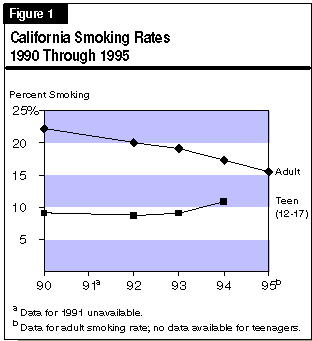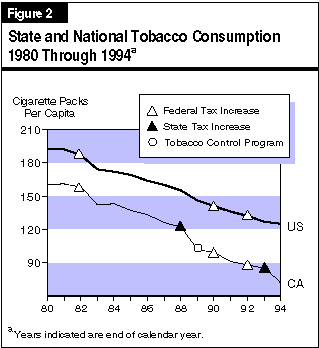

It has been well documented that cigarette smoking has adverse effects on individuals health. Consequently, any change in the incidence of smoking in the general population can have a significant impact on public spending for health care. Below we review the recent trends in smoking, both in California and the nation.
Adult Smoking Rate Has Declined. The percentage of California adults who smoke (smoking rate) fell from about 22 percent in 1990 to 15 percent in 1995 (first six months). The reduction of 6.7 percentage points represents a 30 percent reduction in the rate. In comparison, 25 percent of adults nationwide smoked in 1993 (the latest year in which national data are available from the Centers for Disease Control). This was about 6 percentage points above California s rate in that year. The U.S. Department of Health and Human Services has set a national adult smoking rate target of 15 percent by the year 2000. The Legislature set a more ambitious goal -- a 6.5 percent adult smoking rate statewide by 1999 -- in Chapter 1331/89 (AB 75, Isenberg).
Black and Hispanic Adult Smoking Rates Fell Fastest. Smoking rates fell for all adult ethnic groups in California between 1990 and 1994. Hispanic and black smoking rates dropped the most, falling by 36 percent and 28 percent, respectively. The white smoking rate decreased by 17 percent during this same period, while the Asian smoking rate fell by 20 percent between 1990 and 1993 (the latest year for which data are available). The most recent data indicate a smoking rate of 13 percent for Hispanics and Asians, 20 percent for blacks, and 19 percent for whites.
Teen Smoking Rises -- Especially Among Females. While adult smoking rates in California have declined, teen smoking rates have increased. As Figure 1 (next page) shows, the state's overall teen smoking rate (data are reported for ages 12 to 17) increased from 9.1 percent in 1990 to 10.9 percent in 1994 -- a 20 percent increase. The largest increase was by 14 and 15 year olds, whose smoking rate climbed by 44 percent.

The smoking rate of teenage females increased significantly more than for males. The number of female teen smokers increased by 32 percent between 1990 and 1994. The number of male teen smokers, in comparison, increased by 11 percent.
The rise in teen smoking in California generally parallels the rise nationwide, although methodological differences preclude direct comparisons between state and national figures. While the reasons for this trend are not entirely clear, one factor cited by health care administrators is the apparent impact of targeted advertising campaigns by cigarette manufacturers.
State Tobacco Consumption Declining. As shown in Figure 2, both state and national tobacco consumption levels (measured as cigarette packs sold per adult in the population) have declined steadily since 1980. State consumption levels have declined much faster than the national rate, particularly since 1988, when the Tobacco Tax and Health Protection Act (Proposition 99) was approved by the voters. In California, the state's per-capita tobacco consumption decreased by 24 percent between 1980 and 1988, compared to 19 percent for the nation. More recently, the state's per-capita tobacco consumption decreased by 41 percent between 1988 and 1994, compared to 19 percent nationwide.

Several factors have contributed to the decline in the state's tobacco consumption. A key factor has been the increase in tobacco taxation. As Figure 2 shows, three of the five cigarette tax increases in the past 15 years were followed by sharp reductions in statewide tobacco consumption. Both California and the nation witnessed a significant drop in tobacco consumption in 1983, the year after the federal cigarette tax was raised by 8 cents per pack. After 1988, when Proposition 99 raised the cigarette tax by 25 cents per pack in California, the state experienced its most rapid decline in tobacco consumption. California experienced another sharp decline in 1994, after enactment of Chapter 660/93 (AB 478, B. Friedman), which raised the cigarette tax an additional 2 cents per pack. We note that using in-state cigarette sales as a measure of state consumption trends may overstate the actual consumption declines, to the extent that cigarette purchases are made outside the state in response to higher California tax rates. Nevertheless, increased taxation has clearly reduced consumption.
Another factor that probably contributed to the drop in tobacco consumption in California is the state's Tobacco Control Program, which is administered by the Department of Health Services (DHS) and the State Department of Education (SDE). This program was authorized by Chapter 1331 and implemented in 1989-90. In 1995-96, the Tobacco Control Section within the DHS (1) disbursed $10.2 million to county and city health departments to fund local tobacco prevention and cessation programs, (2) awarded $9.8 million in competitive grants to community-based programs targeting high-risk populations, (3) contracted for a $12.2 million tobacco prevention media campaign, and (4) spent $3.1 million to evaluate state smoking trends. The SDE allocated $17.1 million to counties and school districts for school-based tobacco education and cessation projects.
Other factors also may have contributed to the decline in smoking in California. These include (1) increases in the number of state and local restrictions on public smoking and smoking in the workplace, and (2) greater public awareness nationwide of the health hazards related to smoking.
Effect of Reduced Consumption on Proposition 99 Revenues. The decline in smoking consumption has resulted in lower Proposition 99 revenues, which fund a variety of prevention and health programs. Specifically, Proposition 99 revenues declined from $518 million in 1991-92 to an estimated $436 million in 1996-97 -- 16 percent reduction over the five-year period. As a result, funding for several Proposition 99-funded programs has declined. In particular, funding for DHS's Tobacco Control Section activities and SDE's tobacco prevention and cessation grants decreased by 30 percent and 38 percent, respectively, since 1991-92.
Proposition 99 revenues are projected to decline by about 2 percent between the current and budget years -- much slower rate of decline than in previous years. This is due to a recent trend reflecting an increase in the consumption of noncigarette tobacco products.
It is important for the Legislature to take these trends into consideration when deciding how to allocate Proposition 99 funds. The effect of the declining revenue base, for example, will be particularly significant if funds are allocated to caseload driven programs that tend to increase over time. We note, in this respect, that legislation authorizing the expenditure of Proposition 99 funds sunsets on June 30, 1996. In response, the administration has proposed a plan to reauthorize these funds in the budget year. We discuss this proposal in detail in our Analysis of the 1996-97 Budget Bill.
Contact--Daniel Kim--(916) 445-6061
Economic and revenue developments have remained positive in early 1996. The economy remains on a moderate growth track, while revenues are running somewhat ahead of the Governor's revised January 1996 budget forecast.
California wage and salary employment jumped by about 30,000 in February, led by gains in a variety of service and trade industries. Employment in the state is now showing year-over-year increases of over 300,000 jobs, which is similar to the annual increases experienced in the late 1980s.
Home sales have picked up in recent months, and this trend is likely to continue, and perhaps accelerate, into the spring. Reports from various realtors' associations indicate major increases in homebuying activity throughout the state. In line with the improvement in sales, new construction activity has trended upward in recent months, although home building in California remains very weak by historical standards.
California taxable sales during the fourth quarter of 1995 increased by about 5 percent from the prior year, suggesting that the 1995 Christmas shopping season was somewhat stronger in California than in the rest of the nation.
Consistent with the generally positive reports on California's economy, total General Fund receipts are running ahead of estimates in early 1996. Total receipts during Janaury and February were up $331 million (1.2 percent) from the new budget forecast, largely reflecting gains in personal income taxes (up $259 million) and sales taxes (up $95 million). The increases from both of these sources are tied closely to current economic activity and appear to be permanent. For example, a substantial portion of the personal income tax gain is related to stronger-than-expected withholding payments, which were up 15 percent from the prior year in February. While the continued stronger-than-expected growth in state employment accounts for part of the gain, other factors -- such as large year-end bonuses -- may also be playing a role.
March and April are key revenue months. Final bank and corporation tax payments are due this month, while individual final returns are due in April. Reports through mid-March suggest that final corporate payments are running slightly above the budget forecast. However, the final result for the month will also be influenced by other factors (such as audit collections and refunds).
Contact--Brad Williams--(916) 324-4942